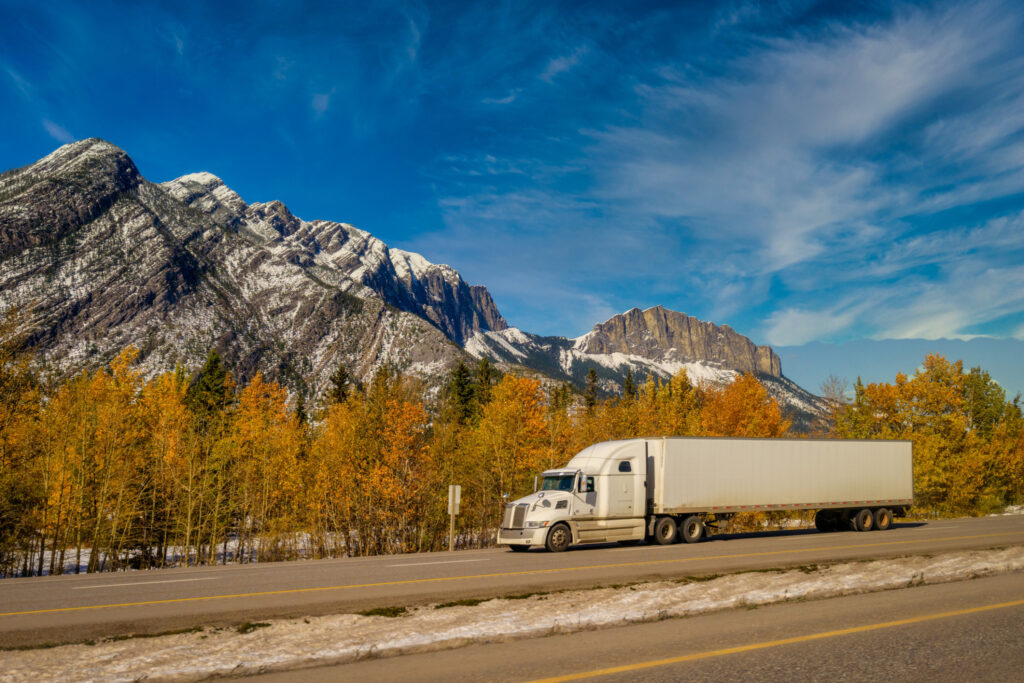Trucker Access › Forums › Diesel News › A common sense approach to reducing interprovincial trade barriers for trucking
- This topic has 0 replies, 1 voice, and was last updated 5 months, 4 weeks ago by
 EazyRiDer66.
EazyRiDer66.
-
AuthorPosts
-
May 28, 2024 at 8:00 pm #22747
 EazyRiDer66Keymaster
EazyRiDer66KeymasterCanada’s hodgepodge of trucking regulations makes it highly inefficient to deliver freight from coast to coast by truck, as anyone in the industry would attest.
However, a new report attaches a cost to international trade barriers on the trucking industry – and by extension, the Canadian economy – and suggests an interesting method of reducing some of those barriers. Doing so would give Canada’s GDP a meaningful, and much needed shot in the arm, while simplifying interprovincial trucking.

(Photo: iStock) Roadblocks Ahead – Internal barriers to trade in Canada’s truck transportation sector, was issued recently by the Macdonald-Laurier Institute (MLI), a non-partisan national public policy think tank. The report suggests inconsistent trucking regulations across Canada add about 8.3% to freight rates.
That totals about $500 million in direct economic losses, but when taking into account the cascading effects on other sectors, MLI estimates the cost to Canada’s GDP to be closer to $1.6 billion per year.
That’s a sizeable number and one that should get policymakers to consider new ideas to improve the flow of goods across provincial borders. MLI, in its paper, presents the concept of Mutual Recognition Agreements (MRAs) as the potential answer.
Mutual Recognition Agreements
Complete regulatory harmonization of trucking regulations from coast to coast is daunting and burdensome, the paper acknowledges. By contrast, an MRA is a simpler way to eliminate cross-border trade barriers. What’s an MRA?
“Briefly defined, mutual recognition requires a host province to accept the standards set out by the province from which the good or service originates,” the paper explains. “In contrast, harmonization requires establishing common standards that will be adopted uniformly by both the host and originating province.”
MRAs have their limitations. They can’t be used to overcome regulatory inconsistencies where permanent infrastructure (ie. bridge heights) is concerned, the report’s authors acknowledge. But they still find there are significant opportunities where MRAs can be used to reduce interprovincial trade barriers.
Oversized load permits
Take for instance the issuance of overweight/oversized load permits. The paper suggests provinces should recognize permits issued by any jurisdiction – even those outside its own provincial borders.
Another suggestion is for MRAs to accept the qualifications of licensed long combination vehicle (LCV) drivers, regardless of where those qualifications were obtained or what exactly they entail.
Other areas that could be covered by an MRA include: variations in trailer registration validity periods; acceptance of 60.5-foot trailers across Canada; and inconsistent oversight and monitoring of trucking companies. (Some of these issues, and others, were highlighted by the Canadian Trucking Alliance in its own report on the issue).
Revenue sharing
There are, of course complications that will need to be worked through if Canada were to take an MRA approach to reducing interprovincial trade barriers. A province that sees its revenue stemming from permitting fees will be loathe to give that revenue up. Some mechanism of revenue sharing may be needed to ensure fairness.
But the paper indicates the benefits are worthwhile. The biggest winners will be consumers in the have-not provinces, which stand to see the largest GPD gains per capita. This is because those provinces suffer the most from higher trade costs relative to more heavily populated provinces.
If this seems like pie-in-the-sky thinking that will be impossible to put into practice, there is precedent to the contrary. The MLI report points to the United Kingdom, where an MRA-styled agreement increased maximum truck weights across the country from 41 to 44 tonnes.
Emissions reduction
After two years, truck kilometers traveled annually plunged by 134,000,000 km, 50.6 million less fuel was consumed per year, and annual CO2 emissions were slashed by 135,700 tonnes. Now we’re speaking the government’s language.
If government decision-makers have until now been uninterested in making cross-border trade easier for truckers, today’s legislators at least claim to be inspired to reduce transport-related emissions. Greater efficiency in trucking will ultimately not only reduce freight costs, but also the number of truck trips and kilometers traveled to move the same amount of goods. It’s a win-win for the general economy and the environment, to say nothing of those who deliver the goods.
The complete report can be downloaded for free here. It’s worth a read for anyone engaged in the business of interprovincial trucking, but especially for those responsible for regulating such activities.
-
AuthorPosts
- You must be logged in to reply to this topic.